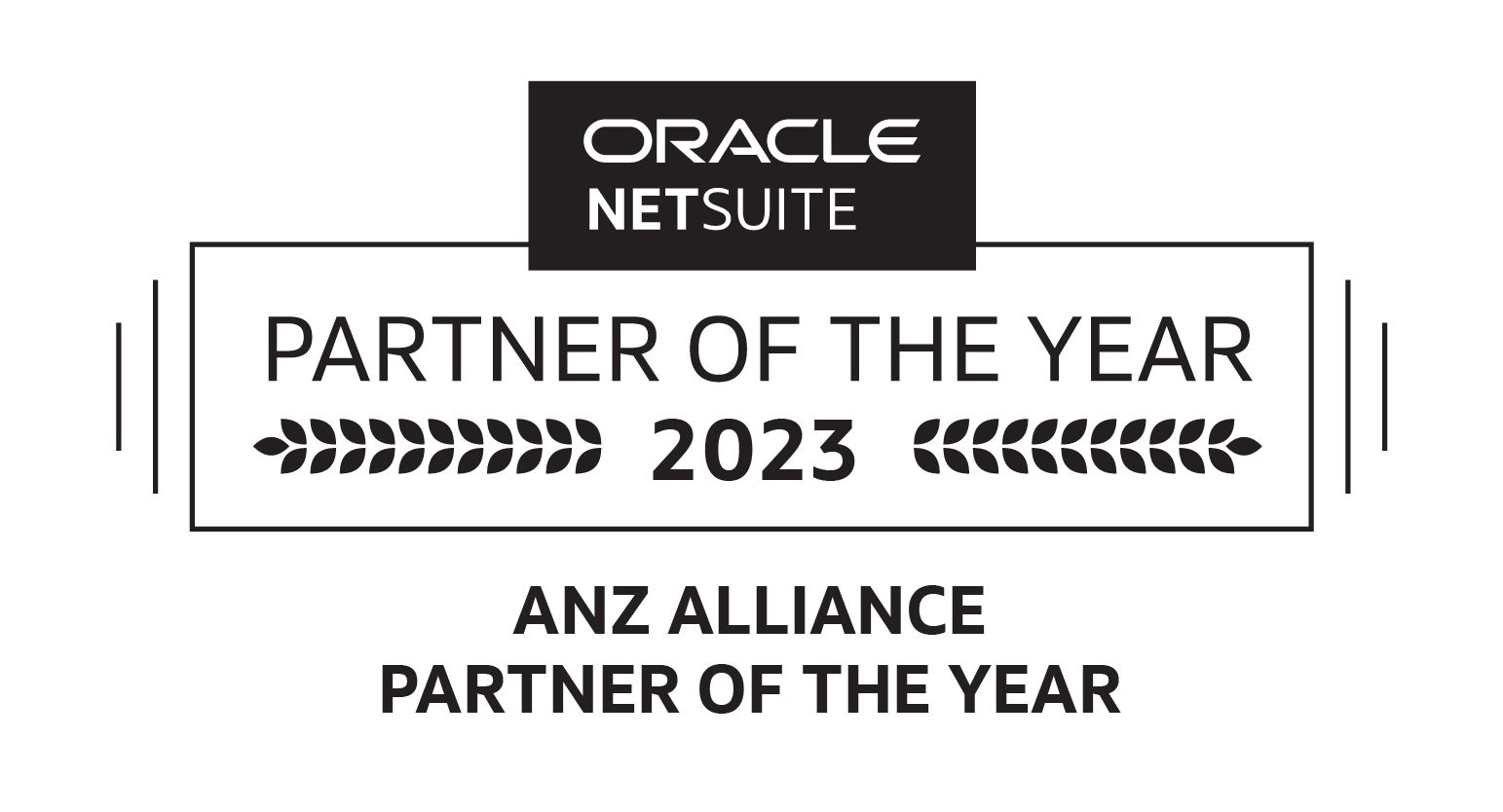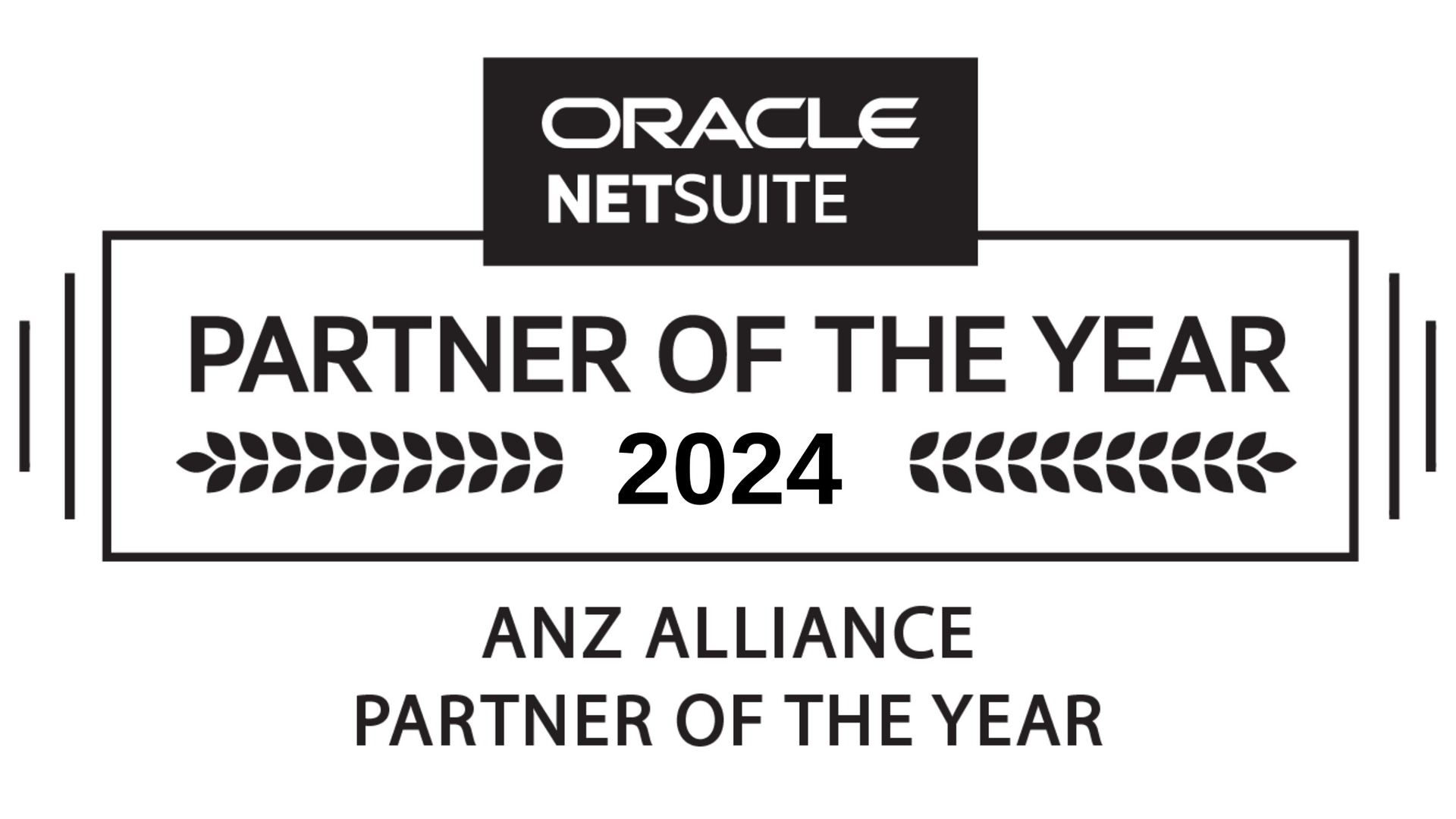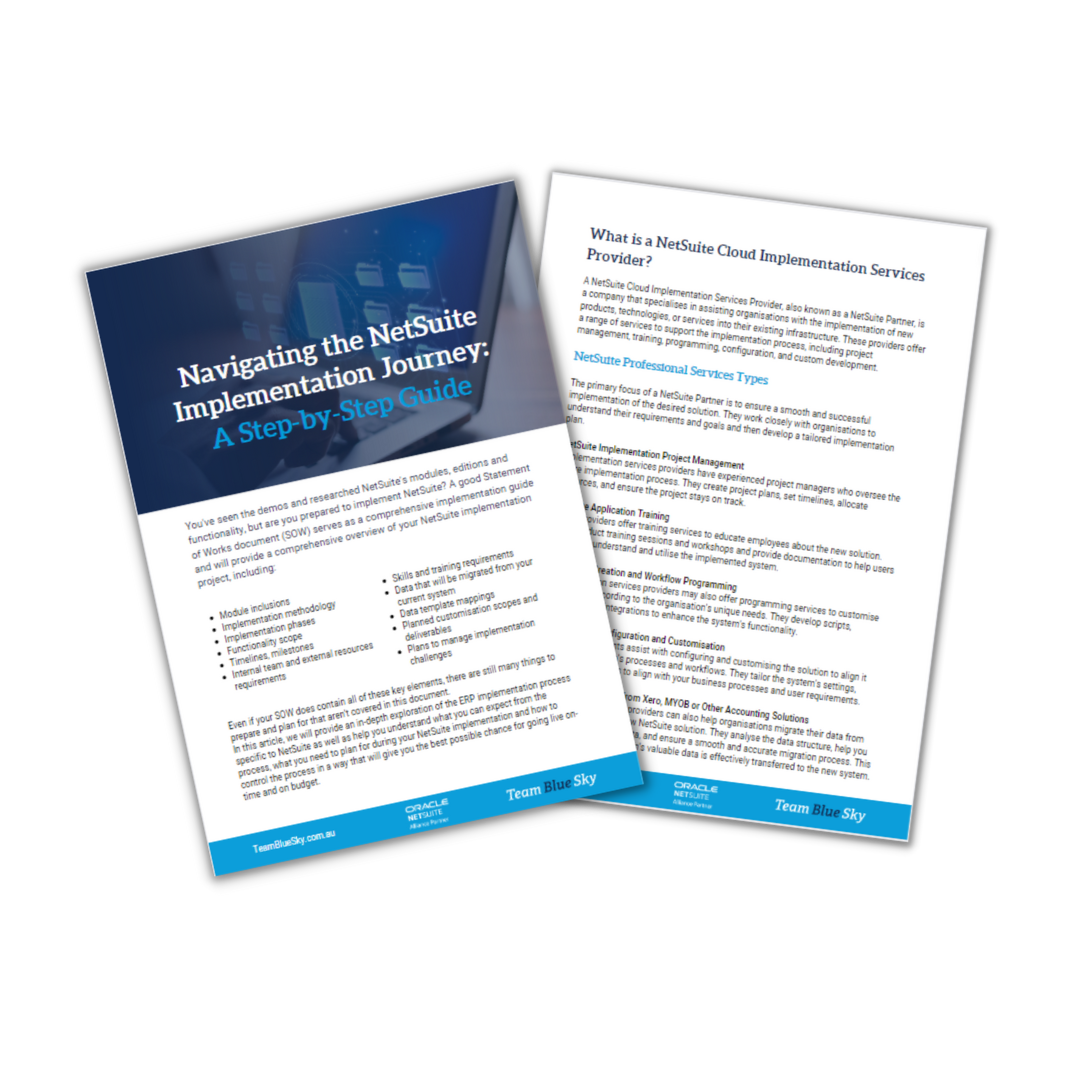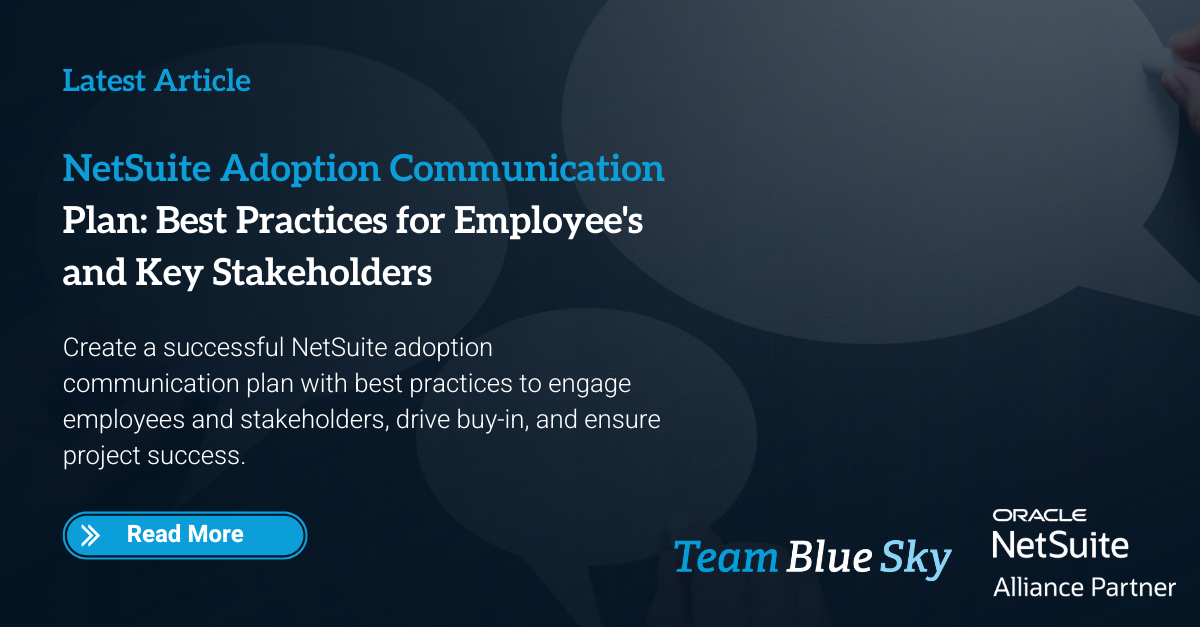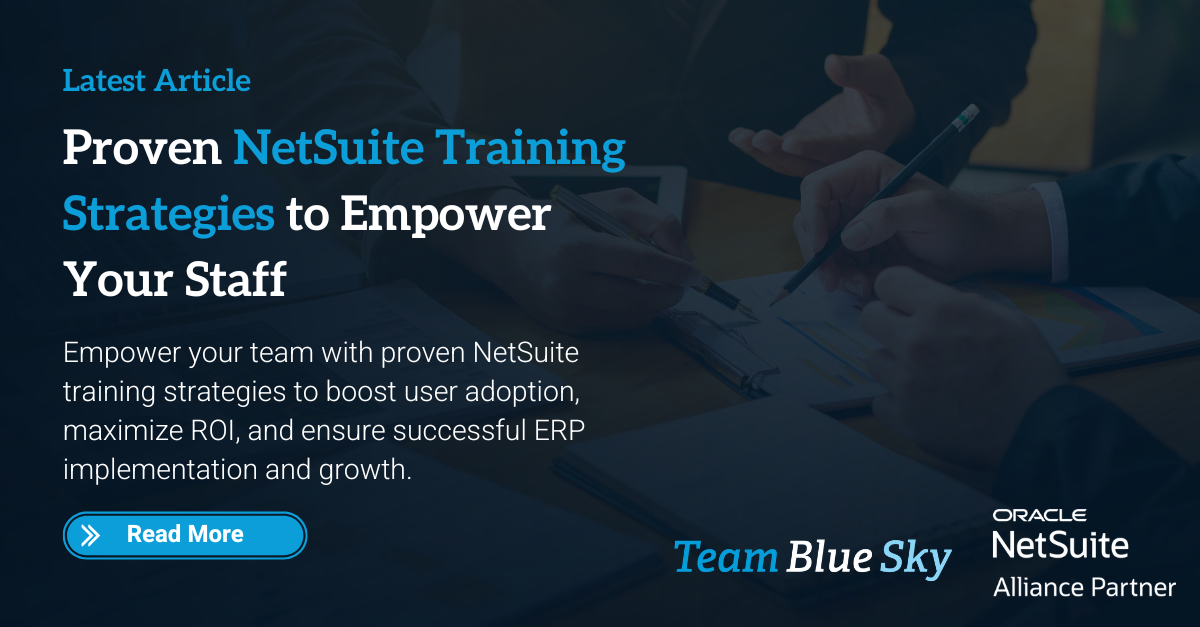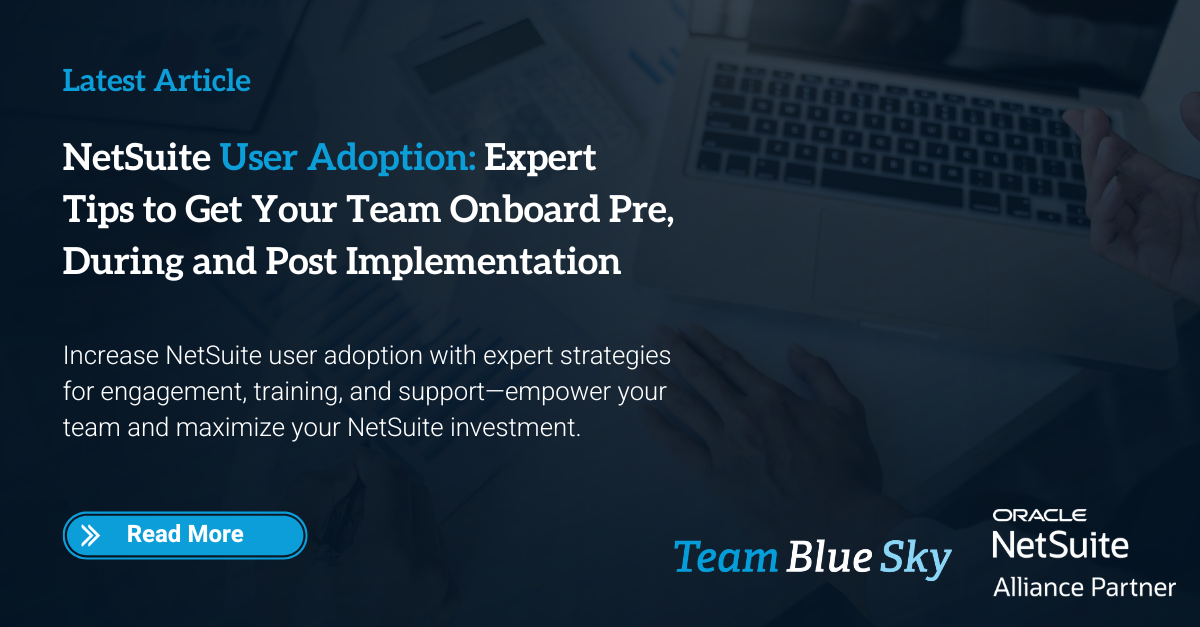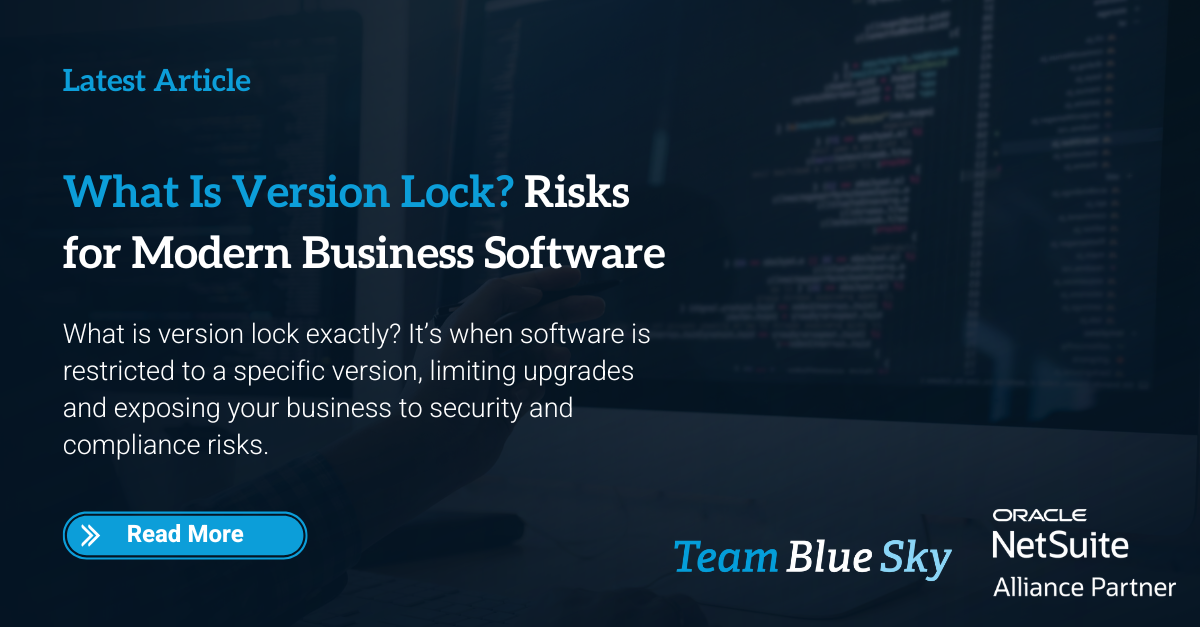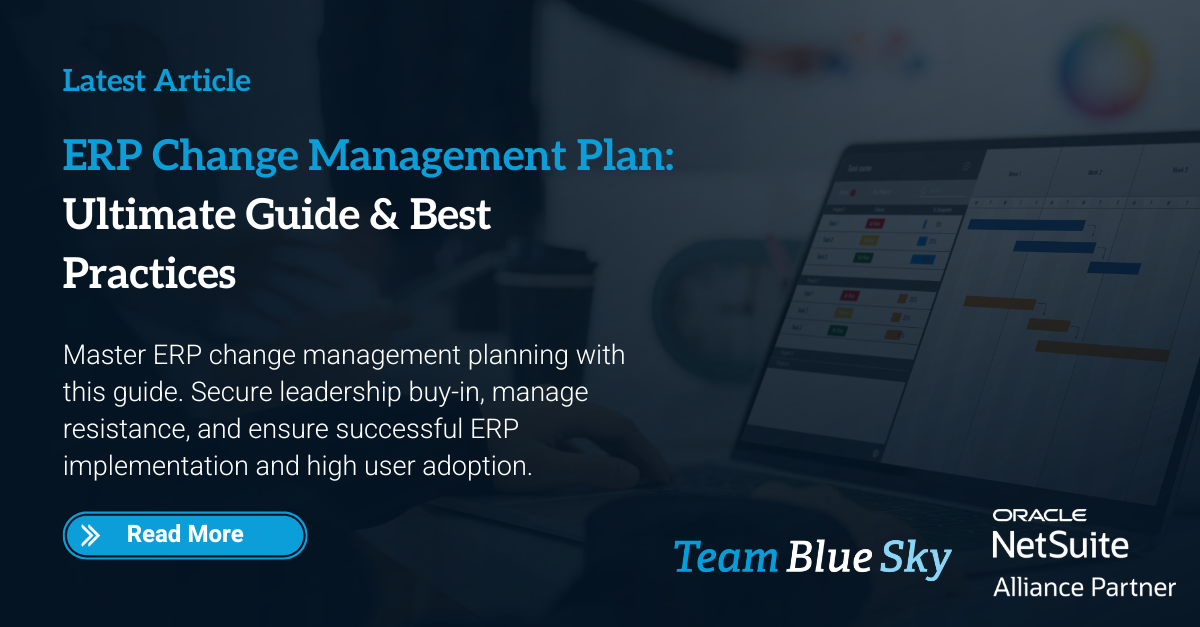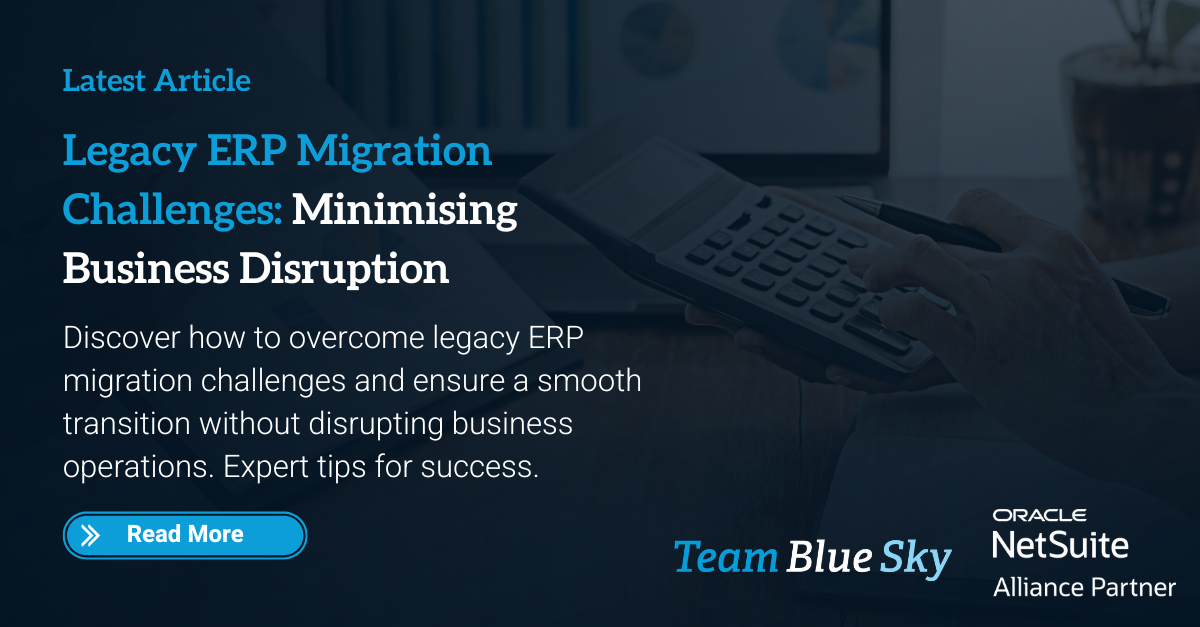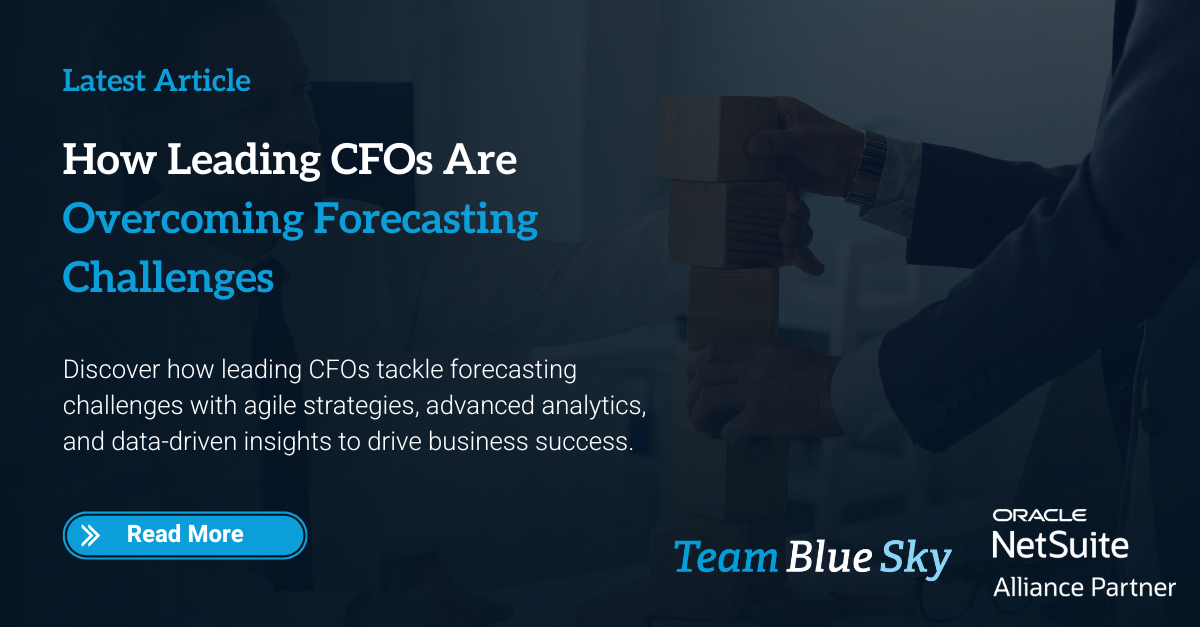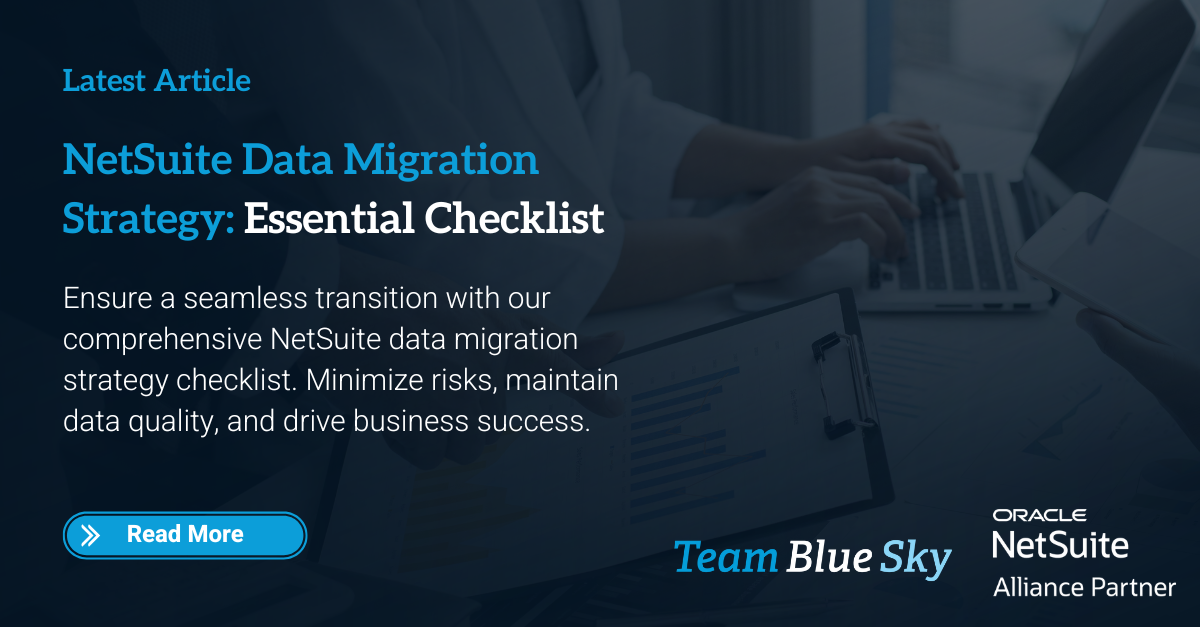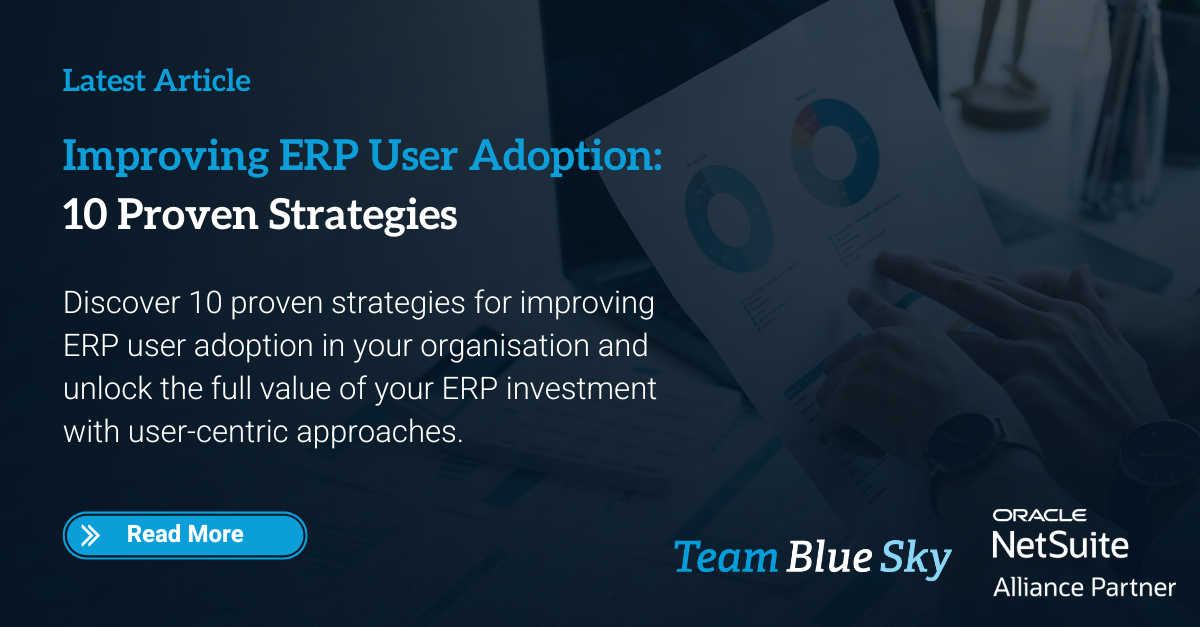Navigating the NetSuite Implementation Journey: A Step-by-Step Guide
You've seen the demos and researched NetSuite's modules, editions and functionality, but are you prepared to implement NetSuite? A good Statement of Works document (SOW) serves as a comprehensive implementation guide and will provide a comprehensive overview of your NetSuite implementation project, including:
- Module inclusions
- Implementation methodology
- Implementation phases
- Functionality scope
- Timelines, milestones
- Internal team and external resources requirements
- Skills and training requirements
- Data that will be migrated from your current system
- Data template mappings
- Planned customisation scopes and deliverables
- Plans to manage implementation challenges
Even if your SOW does contain all of these key elements, there are still many things to prepare and plan for that aren't covered in this document.
In this article, we will provide an in-depth exploration of the ERP implementation process specific to NetSuite as well as help you understand what you can expect from the process, what you need to plan for during your NetSuite implementation and how to control the process in a way that will give you the best possible chance for going live on-time and on budget.
What is a NetSuite Cloud Implementation Services Provider?
A NetSuite Cloud Implementation Services Provider, also known as a NetSuite Partner, is a company that specialises in assisting organisations with the implementation of new products, technologies, or services into their existing infrastructure. These providers offer a range of services to support the implementation process, including project management, training, programming, configuration, and custom development.
NetSuite Professional Services Types
The primary focus of a NetSuite Partner is to ensure a smooth and successful implementation of the desired solution. They work closely with organisations to understand their requirements and goals and then develop a tailored implementation plan.
NetSuite Implementation Project Management
Implementation services providers have experienced project managers who oversee the entire implementation process. They create project plans, set timelines, allocate resources, and ensure the project stays on track.
NetSuite Application Training
These providers offer training services to educate employees about the new solution. They conduct training sessions and workshops and provide documentation to help users effectively understand and utilise the implemented system.
SuiteScript Creation and Workflow Programming
Implementation services providers may also offer programming services to customise the solution according to the organisation's unique needs. They develop scripts, workflows, and integrations to enhance the system's functionality.
NetSuite Core Configuration and Customisation
Technical Consultants assist with configuring and customising the solution to align it with the organisation's processes and workflows. They tailor the system's settings, modules, and features to align with your business processes and user requirements.
Legacy Data Migration from Xero, MYOB or Other Accounting Solutions
Implementation services providers can also help organisations migrate their data from existing systems to the new NetSuite solution. They analyse the data structure, help you clean and transform the data, and ensure a smooth and accurate migration process. This ensures that the organisation's valuable data is effectively transferred to the new system.
Integration of NetSuite to Third-Party Systems
NetSuite Partners can also assist in integrating the NetSuite solution with other third-party systems that the company may be using. They configure the necessary interfaces and APIs to enable seamless data exchange and process automation between different systems. This integration streamlines operations and eliminates manual data entry or duplicate work.
Change Management Planning and Delivery
NetSuite Cloud Implementation Services Providers offer change management services to help companies navigate the transition to the new solution. They develop change management strategies, communication plans, and training materials to facilitate user adoption and minimise resistance to change. These providers ensure that employees are adequately prepared for the implementation and understand the benefits of the new solution.
Go Live Support and Ongoing Support and Maintenance
Providers often provide ongoing support and maintenance services after the implementation is complete. They offer technical support, address any issues or system glitches, and provide system upgrades and enhancements as needed. This ensures that the implemented solution remains up-to-date, optimised, and aligned with the evolving needs of the organisation.
SaaS Implementation Services vs On-Premise Implementation Services
If you have been a part of an on-premise implementation before, you will probably find SaaS Implementation Services to be a very different process with regard to time frames, effort levels, face-to-face contact (in office) with your lead and functional consultants, and complexity.
SaaS Implementation Services are much more streamlined, with the majority of work, meetings, demonstrations and training being conducted remotely via web conferencing technology.
Key Benefits of SaaS Implementation Services
The term SaaS Implementation Services refers to the professional services that occur during the process of deploying and configuring business software hosted in the cloud. SaaS ERP implementations, given their modern technology and remote delivery, offer both NetSuite Partner-side consultants as well as clients and end users the ability to do more in a lot less time. There is also less time spent travelling to provide configuration, customisation and training delivery, which depending on where your partner is, can save tens of thousands of dollars over the course of a standard 3-month implementation.
Streamlined Process
SaaS implementations are typically more streamlined compared to on-premise implementations. The process is designed to be efficient and optimised, focusing on delivering rapid deployment and time-to-value.
Remote Collaboration
Most work, meetings, demonstrations, and training in SaaS implementations are conducted remotely via web conferencing technology. This allows for flexible communication and collaboration without the need for in-person meetings.
Effort Level
SaaS implementations generally require less effort compared to on-premise implementations. The software is already hosted and managed by the service provider, eliminating the need for organisations to set up and maintain their own infrastructure.
Reduced Complexity
SaaS solutions are often designed to be user-friendly and intuitive, reducing the complexity of the implementation process. The focus is on configuring the solution to fit the organisation's specific needs rather than developing or customising the software from scratch.
Impacts of On-Premise Implementation Services for ERP Projects
On-premise Implementation Services involve deploying and configuring software solutions within an organisation's own infrastructure, which typically means experienced consultants need to be on-site for all, if not the majority, of the implementation. While some clients are willing to pay a premium for high-touch project support, the truth is, with modern cloud software, and online communication platforms, the same level of service, if not better, can be provided by a consultant working remotely. Here are some key aspects of on-premise implementations:
Longer Time Frames
On-premise implementations typically require longer time frames compared to SaaS implementations. This is because organisations need to set up their own hardware, software, and networking infrastructure before deploying and configuring the solution. These solutions are usually outdated, except for some Tier One on-premise solutions like SAP 4/Hana, which are designed for large global enterprises. In rare cases, organisations that deal with highly sensitive data such as patient medical records, or data that needs to be hosted within the national borders of the country, for example, defence manufacturers, may prefer this option over cloud services.
Face-to-Face Contact
On-premise implementations often involve more face-to-face contact between the implementation team and the organisation's staff. In-office meetings and consultations with lead and functional consultants are common, allowing for direct interaction and collaboration. These meetings and planning sessions are usually a lot more in-depth and detailed, as with most on-premise ERP, the process of rewriting and editing configurations and customisations can be wildly difficult, so it's best to spend extra time at the begging to ensure good decisions are being made. Comparing this with a Cloud ERP Implementation, like NetSuite, detailing the exact requirements down to a granular level is less necessary, as most critical business processes are already available in the system via the SuiteSuccess leading practices bundles.
Let Your NetSuite Implementation Journey Begin
Now that we have a high-level understanding of cloud implementation services let's start to unpack what will happen from now until you go live with NetSuite.
For convenience, we have created an infographic for you to download to refer to later. Download the Infographic. Similarly, if you don't have time to keep reading or would like to share this article with a colleague, you can download the detailed PDF version here.
Choose Your Own ERP Implementation Adventure
We have three different learning paths, depending on where you are currently at in your NetSuite evaluation. Please click the option that relates closest to your current situation, and our article will update you with the content.
Step 1: Research NetSuite Features and Benefits
Understanding Which NetSuite Edition is Right For Your Business
Before you reach out for a price estimate, it's crucial to have a clear understanding of what NetSuite offers. As a comprehensive ERP solution, NetSuite includes features like financial management, CRM, e-commerce, and supply chain management. Researching these features and understanding how they can benefit your organisation will give you clarity on what you are investing in. NetSuite offers a range of prepackaged modules and functionality under the banner of SuiteSuccess. These industry-targeted editions of NetSuite offer pre-built configurations following industry-leading practices, which is a huge head start when it comes to implementing the system. If you are still determining which edition is right for you, reach out to a reputable NetSuite partner for assistance.
Step 2: Assess Your Business Needs
Identifying Requirements
Assess your organisation's specific needs. Identify the pain points in your current processes and systems that you aim to address through NetSuite. Take stock of your organisation's unique requirements, such as the number of users, required modules, and any customisations or integrations.
Prioritising Needs
It's vital to prioritise your needs. While NetSuite has a wide array of features, your business might only require some of them. Define which features are must-haves and which are nice-to-haves, and start there to simplify your implementation process.
Step 3: Request a Quote
Contacting NetSuite or a Certified Partner
With a clear understanding of your needs, it's time to request a customised quote. You can either contact NetSuite directly or reach out to a certified partner for guidance. Provide them with the details of your requirements and any conversations you've had with either NetSuite or other partners, and disclose if you have already received estimates previously.
Discussing Your Needs
Engage in discussion with either your NetSuite sales representative or partner. This is your opportunity to ask questions and get insights into the best configuration options for your organisation. It is also important to discuss your budget for both annual licence fees and services, as well as your implementation timeline goals.
Step 4: Seek Expert Advice
Consulting an Independent ERP Consultant
If you're uncertain or have questions about the estimate, feel free to seek expert advice or a second opinion. Consulting an experienced NetSuite partner can provide you with unbiased insights into whether the NetSuite Edition and module list quoted is the right choice for your business and if the price estimate is reasonable and in line with NetSuite's discount thresholds.
Option 2: Assessing Implementation Costs and Getting a NetSuite Implementation Estimate
Embarking on the path of implementing NetSuite for your business is an exciting venture. If you have already received a NetSuite License Fee Estimate but have not yet gotten an Implementation Services Estimate, this section is tailored for you. Understanding the financial scope of your project is crucial. Here's a step-by-step guide to ensure that you have all the necessary NetSuite cost-related information to proceed.
Step 1: Understand Implementation Costs
It's vital to recognise that besides licensing, there are other costs associated with implementing an ERP system like NetSuite.
Consulting
You will need the expertise of functional and technical consultants to guide you through the implementation process and ensure you reach your go-live on time and on budget and that your NetSuite solution meets the requirements of your business, departments and end users. NetSuite Alliance Partners, like TeamBlueSky, don't receive any commission from NetSuite for sales, so they are not incentivised to sell you more than you need. A good NetSuite Alliance Partner will offer independent, unbiased advice on how NetSuite can be adapted to suit your business processes.
Customisation
One of the strengths of NetSuite is its ability to be customised. Depending on your specific requirements, you might need custom modules or modifications to the existing ones. Enlisting the services of a partner will give you access to NetSuite development experts who can help create functionality beyond NetSuite's out-of-the-box capabilities and fine-tune the system to automate your processes in ways you never thought possible.
Training
Training is an often-underestimated aspect of implementing new software. Your workforce needs to be proficient in utilising NetSuite to the fullest to ensure a good ROI.
Step 2: Request Implementation Services Estimate
Now that you are aware of the various cost components, it's time to get a detailed estimate. You can contact NetSuite directly or reach out to certified partners. It is often beneficial to request estimates from multiple sources to get a range of options.
Step 3: Evaluate Total Costs
Armed with the implementation services estimate, add it to the license fee to calculate the total cost of ownership. Make sure you account for all elements - consulting, customisation, training, and any additional fees that may arise.
Step 4: Set a Budget
With a clear understanding of the total costs, it's time to set a budget. This budget should not only account for the known costs but also have a contingency fund, usually around 10%, for companies who operate in NetSuite's less complex industries, like wholesale distribution or Finanacials First. For businesses with more complex industry requirements, like software, manufacturing, field service or complex global companies, 20% is a safe contingency fund if you have chosen a good NetSuite partner. Having a buffer can keep you from having to make compromises later in the implementation.
Step 5: Finalise Vendor
After setting your budget, it's time to choose your vendor for both the license and implementation services. When making this decision, don't just consider the costs. Look into their track record, expertise, and the level of support they offer. Making the right choice here is crucial to the success of your NetSuite implementation.
Set Clear Goals During the Planning Phases
Set clear, achievable goals for the implementation. Having well-defined goals will serve as the guiding light throughout the implementation process and help in measuring the success of the project.
Confirm Already Established Objectives
By now, you and your NetSuite partner should have clearly defined the objectives of the implementation and created a Statement of Works document to serve as your NetSuite project bible. Knowing what you want to achieve helps in keeping the project on track.
Establish Communication Channels
Ensure everyone knows how communication will be handled. Clear communication channels help in nipping issues in the bud quickly, minimising the risk of project failure. It is important to document contact, preferred communication channels (phone, email, in-person), best contact numbers, and key responsibilities and decision-making authority. Also, creating communication ops documentation will help your project team to know how to manage any issues that arise.
Step 2: Assembling Your Project Team
Assembling a well-rounded project team is a crucial step in any ERP implementation project. The people you include in this team will be instrumental in determining the success or failure of the implementation. Here are some key aspects to consider:
Internal and External Teams
Select members from different departments who have intimate knowledge of day-to-day operations. Their insights will be invaluable in ensuring the new system aligns with the organisational needs. Include these subject matter experts:
Executive Champion
An executive-level project sponsor and champion is crucial for project prioritisation. It is easy to deprioritise special project tasks in favour of standard business management tasks, so having someone to maintain project progress and momentum is vital.
Senior Managers
Senior managers have a deep understanding of their department's processes, people and software functionality requirements. Include senior managers from your most important business departments, including Sales, Accounting, Operations, Warehouse Management, Service Delivery and Project Management, if applicable.
Technical Staff
There are a number of client-side technical tasks that occur during implementation. Some examples include data cleansing and preparation for migration, system documentation, and integration planning. Having a technical team member with IT experience massively increases a project's chance of success.
End Users
Remember the little guy. Whilst managers are important in defining your business requirements, sometimes they aren't across the nitty-gritty of daily tasks. Having end-users involved in the project also gives them a chance to become deeply connected to the project and learn the solution ahead of go-live, making them invaluable assets during training phases and post-go-live.
Assign a Project Manager
Having someone at the helm is crucial. The client-side project manager should be someone with strong leadership skills and prior experience in project management, preferably in ERP implementations. The project manager will:
- Oversee the project's progress.
- Manage resources.
- Ensure the project stays on track and within budget.
- Act as a point of contact between the internal team, the implementation partner, and any other third parties.
Resource Planning
It's essential to ensure that the team members have enough time to dedicate to the project. Some members, especially key users, still need to achieve their day-to-day KPIs. Proper resource planning ensures that there are no bottlenecks due to time constraints and that additional workloads are planned for.
Steering Committee
Establish a steering committee that makes high-level decisions about the project. This committee should consist of top executives and stakeholders who have the authority to make decisions.
Managing Workloads
ERP implementation projects can be resource-intensive. It is crucial to manage the workloads of the team members effectively. This might require:
Temporarily Offloading Daily Responsibilities
Team members who are critical to the implementation might need to be relieved of some of their daily tasks.
Bringing in Temporary Help
Sometimes, it's not possible to relieve team members of their daily tasks. In such cases, temporary staff can help in ensuring that the daily operations are not impacted.
Time Management
Proper time management can help in ensuring that the team members involved in the project are not overloaded. This includes not just the daily tasks but also the tasks related to the implementation.
Building a Cohesive Team
Building a team is not just about throwing people together. It's about building a cohesive unit that can work together effectively. Regular meetings, clear communication channels, and team-building activities are critical in building a cohesive team.
Remember, people and their knowledge about business processes and requirements are the most important factor in the success of any ERP project. By ensuring that you have the right people, the right skills, and the right workload, you are laying the foundation for a successful NetSuite implementation.
Step 3: Aligning Business Processes with NetSuite Configurations
Aligning your business processes with NetSuite configurations is a critical step that ensures your new ERP system supports and enhances the way your business operates. This step is multifaceted and includes understanding existing processes, configuring NetSuite, customising it as needed, and conducting use-case testing.
Customise and Configure
Customisations
Based on the mapping and analysis, there may be a need for customisations to make NetSuite work according to your agreed-upon business requirements. This could include creating custom fields, workflows, or forms. It's crucial to ensure that customisations are thoroughly documented for future reference and maintenance.
Integrations
Your business may also be using other systems that need to integrate with NetSuite, such as CRM, eCommerce platforms, or third-party applications. Work with your implementation partner to develop and test these integrations ensuring data flows smoothly between systems and behaves as expected.
Proof of Concept Demonstrations
Before finalising the customisations and configurations, your implementation partner may create proof-of-concept demonstrations. These are prototypes that demonstrate how specific functionalities will work in the customised NetSuite environment. This helps in validating that the configuration meets your business requirements.
Testing and Validation
Once you have configured and customised NetSuite, it's critical to test it thoroughly. This should include the following:
Functional Testing
Ensuring that all business processes function as expected within NetSuite.
Integration Testing
Making sure that any integrations with other systems are working properly.
User Acceptance Testing (UAT)
This involves having end-users test the system to ensure it meets their needs and expectations.
Finalising the Configuration
After a rigorous testing process, validation, and any necessary adjustments, the final configuration is completed. This configuration should align closely with your business processes, ensuring that NetSuite effectively supports your business goals.
Aligning business processes with NetSuite configurations is a complex but critical phase in the implementation process. By carefully mapping, customising, configuring, and testing the system, you'll help ensure a smooth transition and maximise the value of your NetSuite investment.
Step 4: Data Migration
Data migration is a pivotal phase in the NetSuite implementation process. It involves the transfer of your business's existing data to the NetSuite platform. This data may include customer records, financial data, inventory details, and other relevant business information. Ensuring that this data is migrated accurately is essential for the smooth operation of your business.
Planning for Data Migration
Assess the Data
Begin by assessing the data that needs to be migrated to help you understand the volume, complexity, and formats of the data in your legacy systems. Determine what data is essential to transfer and what can be archived or discarded.
Data Cleansing
Data cleansing is the process of fixing or removing data that is incorrect, incomplete, improperly formatted, or duplicated. Since migrating data to a new system provides an opportunity to start fresh, it is best practice to cleanse the data before importing it into NetSuite.
Data Mapping
This is the process of matching the source data fields to the corresponding target fields in NetSuite. Understanding the data structure of NetSuite and how it corresponds to your legacy data is critical. This phase often involves the transformation or conversion of data into formats compatible with NetSuite.
Develop a Migration Plan
Create a detailed migration plan that outlines each step of the process, including timelines and responsibilities. It should also include a strategy for handling errors or issues that may arise during the migration.
Execute Migration
Choose the Right Tools
Selecting the appropriate data migration tools will depend on the complexity and volume of the data. You might use NetSuite's built-in import tools, or you might need more sophisticated ETL (Extract, Transform, Load) tools.
Pilot Migration
Conduct a pilot migration with a small subset of your data. This will help you identify any issues with the data or the migration process itself before you complete the final migration.
Full Migration
Once you are satisfied with the pilot migration, proceed with the full migration according to the plan. Continuously monitor the process for any errors or issues, and report any issues to the right person as identified in your communication and contact plan.
Validate the Data
After the data has been migrated, it's critical to validate it to ensure that it has been accurately transferred. Check for any inconsistencies or errors and confirm that all data is in the correct format.
Post-Migration Review
Conduct a post-migration review to analyse the migration process and identify any lessons learned. This review can be valuable for understanding what went well and what could be improved for future migrations.
Step 5: End User Training
Develop Training Materials
Identify Different User Roles
Begin by identifying the different user roles within your organisation. Understand that different roles will interact with NetSuite in different ways. For instance, sales representatives might use the CRM module, whereas accounting personnel might be more involved with financials.
Create Customised Training Content
Develop training materials tailored to each user role. Customised content ensures that employees receive relevant information and training that aligns with their responsibilities. These materials can include user manuals, cheat sheets, FAQs, and video tutorials.
Incorporate Real-Life Scenarios
Including real-life scenarios and examples in the training materials can help users understand how to apply the features of NetSuite in their day-to-day tasks.
Conduct System Training Sessions
Plan a Training Schedule
Create a training schedule that aligns with the project timeline. Make sure that training is scheduled well before the go-live date but also close enough that users will retain the information.
Hands-On Training
Hands-on training sessions, where users can actively engage with the system, are often more effective than passive learning. Set up a sandbox environment where users can practice without affecting live data.
Workshops and Webinars
Conduct workshops for group training and problem-solving. This is also an opportunity for users to ask questions and share experiences. Webinars can also be effective, especially for remote teams.
Utilise Online Tutorials and Courses
Online tutorials and courses are an excellent way for users to learn at their own pace. NetSuite offers a variety of official training resources, and there are third-party providers as well.
Monitor and Support
Closely monitor the progress of users during the training phase. Offer support and additional training as needed.
Gather Feedback
Collect feedback from the users about the training. This will help you understand what aspects of the training were effective and what could be improved.
Step 6: Going Live
The 'Go Live' stage is when you make the transition from your legacy system to the newly implemented NetSuite environment. This is a critical phase and must be executed with precision to ensure minimal disruption to business operations. Proper planning, clear communication, and effective change management are key to a successful transition.
Final Checks and Validations
Establish a Change Management Team
Ahead of go-live, assemble a change management team to oversee the transition. This team will be responsible for communicating changes, addressing concerns, and helping users adapt to the new system.
Communicate the Transition
Clearly communicate the transition process to all stakeholders. This should include the go-live date, any expected downtime, and what users need to do during the transition.
Implement a Support Structure
Establish a support structure for users to reach out to in case they encounter issues during the transition. It's a good practice to funnel support requests through a single point of contact, often termed a 'support champion,' who can filter and prioritise issues.
The champion should be responsible for filtering the support tickets and identifying whether it's a system issue or a user/training issue. This helps streamline requests and ensures that they are addressed by the appropriate team, as well as ensuring your partner isn't receiving and creating tickets for the same issues that are reported by different people, which can result in unnecessary support costs.
Consider a Phased and More Controlled Rollout
Consider doing a phased or controlled rollout where you initially launch the system to a smaller group of users before rolling it out company-wide. This can help in identifying and fixing any last-minute issues before being rolled out into other departments.
Lessons Learned from Over 200 Go Lives
Going live is one of the most critical phases in the NetSuite implementation process. Ensuring thorough preparation, clear communication, and effective change management will be key to a successful transition. By monitoring and optimising the system post-launch, you can ensure that NetSuite effectively meets the needs and expectations of your organisation.
Step 7: Post-Implementation Support
After your NetSuite system is live and being utilised by your organisation, it's essential to continue monitoring the system and ensure that users receive the necessary support. This phase is crucial for long-term success and maximising the benefits of your new ERP system.
Monitor and Optimise
Continuous Monitoring
Regularly monitor the system's performance and user activity to identify any issues that may arise. Keep an eye on system logs, error reports, and user feedback.
Regular System Audits
Conduct regular audits and ERP health checks of your NetSuite environment to ensure that the system is compliant with industry standards and organisational policies.
Engage with a NetSuite Support Partner
Whether you choose to maintain an ongoing support relationship with your implementation partner will obviously depend on your experience during implementation. Arrange a session with them, including your project team and the partner's consultants that worked on the project to resolve any issues.
Address User Feedback
As users get more familiar with the system, they may have suggestions for improvements or identify issues that weren't evident initially. Be proactive in addressing this feedback and making necessary adjustments where it makes sense.
Plan for Scalability
As your business evolves, your NetSuite system will need to adapt. Plan for scalability by periodically reviewing your configurations and customisations to ensure they align with your business's current and future needs.
Evaluate Success
Measure Against Objectives
Reflect back on the goals and objectives set out at the beginning of the implementation. Measure the current state against these objectives to evaluate how successful the implementation has been.
Analyse Business Impact
Examine the impact on business operations. Has there been an increase in efficiency? Has data accuracy improved? Has the new system supported better decision-making? If so, it is important to communicate this information to executives, as future investment in the platform will be closely tied to business outcomes. Remember, positive outcomes don't just have to be about increases in revenue, reduction in costs, or obvious time savings. Sometimes the positive impacts of ERP systems are not obvious. An example of this would be your team's overall job satisfaction as a result of having access to better information or streamlined workflows. It's important to consider both the hard and soft impacts equally.
Consider Managed Services for System Administration
Engaging a managed services provider can be highly beneficial for offloading system administration tasks. This allows your internal resources to focus on core business activities while experts handle the day-to-day management of your NetSuite system. Here are some of the benefits of working with a NetSuite managed services provider:
Expertise on Demand
Managed services providers have specialised expertise in handling NetSuite administration. They can ensure that your system is optimised and running smoothly and provide a failsafe option for tackling any issues to support requirements quickly.
Cost-Effective
Outsourcing system administration can be more cost-effective than hiring and training an in-house team, especially if you do not require full-time resources to manage your system.
Proactive Maintenance
A managed services provider will perform proactive maintenance, such as regular system audits, updates, and security checks, to ensure that your NetSuite environment remains robust and secure. They can also help you understand new functionality and modules that become available over time and how your business might benefit from implementing them into your processes.
Scalability and Flexibility
As your business grows, a managed services provider can easily scale the services provided to match your changing needs. This flexibility is vital for adapting to the dynamic nature of business operations.
Including managed services as a part of your post-implementation strategy can contribute to a more efficient, secure, and optimised NetSuite environment, ensuring that your organisation can fully leverage the advanced capabilities of the system while maintaining focus on core business objectives.
Expert Advice When You Need It
The Importance of Expert Advice
Sometimes during your NetSuite implementation journey, you might find yourself in need of a second opinion or expert advice. This is a normal part of navigating the complexities of implementing a powerful ERP system like NetSuite. It is important to remember that you do not have to go through it alone. The TeamBlueSky are ready to provide you with insights, expertise, and advice that are essential in maximising the benefits of your NetSuite investment.
TeamBlueSky's Comprehensive Services
Pre-Implementation Phase
TeamBlueSky offers support right from the start. During the pre-implementation phase, our experts assist you in understanding your unique business requirements and help in crafting an implementation plan tailored specifically for your organisation. This initial stage is crucial in setting a solid foundation for the subsequent phases of the implementation.
Execution Phase
As you move into the execution phase, TeamBlueSky's professionals are there to ensure that everything goes smoothly. Whether it's system configuration, data migration, or user training, our team lends their knowledge and experience to facilitate a seamless process.
Post-Implementation Phase
The journey doesn't end once you go live with NetSuite. In the post-implementation phase, TeamBlueSky offers ongoing support and optimisation services. Continuously monitoring the system for any issues and engaging with TeamBlueSky enables your organisation to promptly address any hiccups and optimise the system for peak performance.
Partnering for Success
When you work with TeamBlueSky, you're not just getting a service provider - you're gaining a partner. Our professionals have a deep understanding of the capabilities of NetSuite and how they can be effectively leveraged to drive business success. Our commitment is towards ensuring that your NetSuite implementation isn't just a technical exercise but a strategic asset that transforms your operations and delivers substantial value to your organisation.

Henry Sack
General Manager

With over 12 years of experience as a NetSuite implementation consultant, Henry Sack leads TeamBlueSky’s team of NetSuite and accounting experts in his role of General Manager.
TeamBlueSky is a leading Australian
NetSuite Alliance Partner whose mission is to provide critical
NetSuite BPO and
Payroll services to NetSuite clients who are wanting to simplify their
back office processes and partner with a leading
NetSuite administration expert.
TeamBlueSky have also partnered with global Suite Developer Network partners to offer local solutioning, implementation and support services for global NetSuite SuiteApps.


